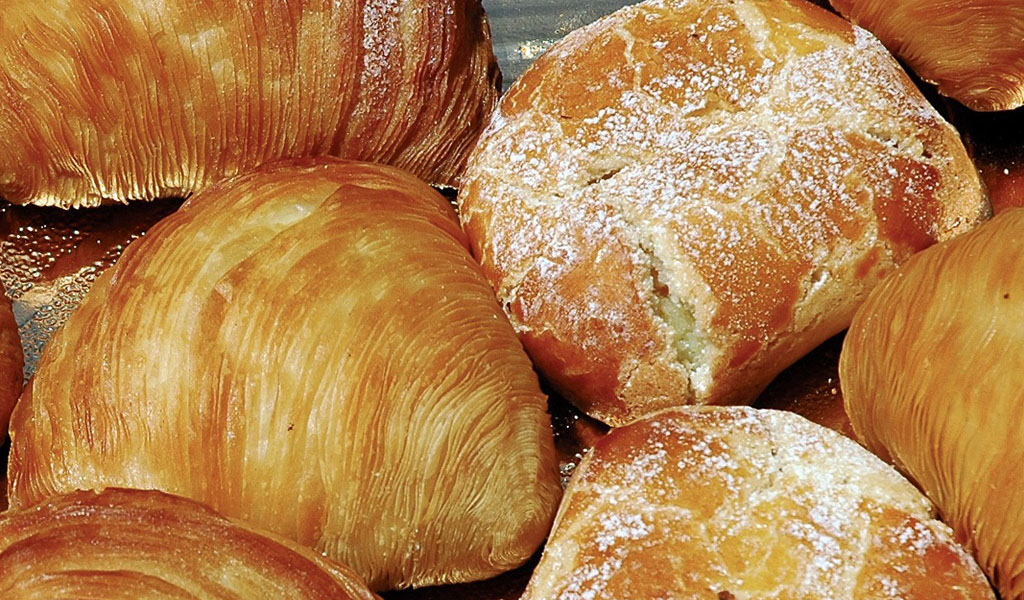Prodotti tradizionali
Sfogliatella

Circa 400 anni fa una monaca convento di clausura di Santa Rosa a Conca dei Marini, in provincia di Salerno, preparando il biancomangiare, un dolce composto da semola cotta nel latte, sbagliò le dosi e decise di sperimentare una nuova creazione: aggiunse all'impasto alcune gocce di limoncello, dei pezzi di susine, albicocche e pere disseccate. Pose, poi, il composto fra due "pettole" cioè pezzi di pasta di pane insaporita con mezzo bicchiere di vino, strutto e dello zucchero e alla fine pose la "grandissima sfogliata" nel forno molto caldo ed attese che si indorasse. La Badessa apprezzò molto la nuova ricetta e dispose che il dolce fosse intitolato alla santa fondatrice dell'ordine, Santa Rosa, e che fosse preparato ogni 30 agosto in occasione della festa della santa. La Santa Rosa si componeva, dunque, di molteplici e sottili sfoglie sovrapposte, era confezionato a forma di conchiglia o cappuccio, e arricchito da un cordone di crema e di marmellata di amarena. La dolce ricetta trapelò dal convento intorno al 1800 e, con alcune variazioni, come, ad esempio, un ridimensionamento della forma, la sostituzione dei frutti secchi con i canditi e l'eliminazione della crema pasticciera, divenne la specialità di un osteria del cuore della città e prese il nome di sfogliatella. Da allora l'osteria che aveva trasformato la Santa Rosa in sfogliatella si trasformò lei stessa in un laboratorio dolciario specializzato in sfogliatelle e la ricetta del dolce si diffuse in tutte le pasticcerie della la città, sia nella sua variante riccia che in quella frolla. Oggi nella città di Napoli la sfogliatella viene continuamente sfornata ed offerta ai passanti calda, fragrante e profumata di acqua di fiori d'arancio e di zucchero a velo, ed è così famosa da essere entrata nel lessico partenopeo, in un detto che la dice lunga sulla considerazione in cui è tenuta dalla città: "Napule tre cose tene belle: ‘o mare, ‘o Vesuvio, e ‘e sfugliatelle".
About 400 years ago a nun from the hermitage of Santa Rosa at Conca dei Marini, near Salerno, while she was preparing a cake called "biancomangiare", made a mistake with the dosage and decided to experiment with a new creation. She added a few drops of limoncello, pieces of dried plums, apricots and pears. She put the mix in two "pettole", pieces of bread dough enriched with wine, lard and sugar and then put the "grandissima sfogliata" in a very warm oven. The Abess was very happy with the new recipe and decided to dedicate it to Santa Rosa, founder of the order and prepare it every year on the 30th of August, the Saint's religious celebration day. "Santa Rosa" was made of many thin overlapping layers, in the shape of a hood with a strip of cream. In the 19th century the recipe came out of the monastery, with some variations: it was reduced in size, dried fruit was substituted with candied fruit and the cream with ricotta. It became the specialty of a tavern in the center of the city and called sfogliatella. The tavern became a specialized laboratory and the recipe spread all around the city in its two variations: riccia and frolla. Today in Naples sfogliatella is made daily and offered while it's still warm, fragrant and smells of orange flowers and icing sugar. It's so famous that it has become part of a popular saying "Napule tre cose tene belle: ‘o mare, ‘o Vesuvio, e ‘e sfugliatelle" (Naples has three beautiful things: sea, Vesuvio and the sfogliatella).